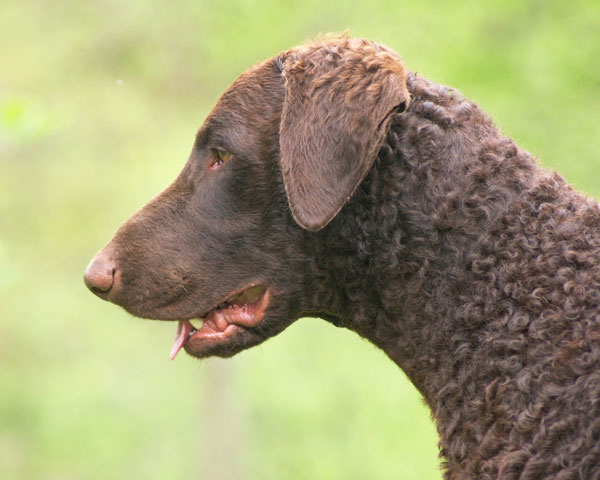Curly Coated Retrievers Have a Double Coat

Are the Curls the Guard Hair?
For years there has been an ongoing debate among curly coated retriever owners on whether the curly had a single coat. Well, to characterize it as a debate would be a slight exaggeration. There were a few of us who questioned the conventional wisdom that curlies were a single-coated breed.
Some curlies maintained a covering of coat at all times even when shedding. What was that remaining coat? Most said it was just the single coat growing in and it didn’t curl yet because it wasn’t long enough. But then what was that coat on the stomach of some dogs: straight and differently textured than the curls? What about the dogs who patterned but still had thin, fine hairs growing in the patterned area? Not enough to hide all the skin but definitely something like peach fuzz.
Researchers have found both primary and secondary hairs in curly coated retrievers, meaning they are double-coated. The primary hairs may not be as harsh as the guard hairs found in some breeds but there are two separate types of hair follicles so that means a double coat.
Researchers Find Both Primary and Secondary Hairs in Curly Coated Retrievers.
Primary hairs are often referred to as “guard” or “outer” hairs. Secondary hairs are often cumulatively referred to as the undercoat.
Find more about curly coated retriever hair on our page summarizing Dr. Bond’s research on hair loss in the breed.
I asked Dr. Ross Bond, of England’s Royal Veterinary College and lead researcher on follicular dysplasia in the breed, about my theory curly coated retrievers had both primary and secondary hairs–or in the common vernacular used by breeders—double coats.
He said I was correct.
Referring to a picture of a cross section of tissue taken from a normally coated area of a curly, Bond pointed out a compound follicle. A compound follicle “is a group of follicles who hairs converge on a commmon ‘pore’ at the skin surface,” he explained.
Bond pointed out that one of the follicles in the compound group is clearly larger than the rest and that is the primary follicle. The hair out of that follicle will be coarser. The other follicles were smaller and hair coming out of those secondary follicles is much finer.
“So, you are correct,” he said about my theory curly coated retrievers have primary and secondary hairs (or outer and inner coats if you will), “and there is the proof!”
Bond added that some breeds have more contrasting and distinctive differences in their primary and secondary hairs than others.
In a study on puppy coat loss and adult hair development, researchers noted size differences of Siberian Husky hairs, for example, were fairly pronounced with the primary hairs being quite large compared to the secondary hairs.
The same study found the primary and secondary hairs in miniature poodles were less distinct and closer in size to each other. (But poodles do have primary and secondary hairs, meaning they have double coats. They just have more hair folllicles in a growth stage than most other breeds and their primary and secondary hairs are similar to each other but the secondary hairs are not as course and display different curvature.)
